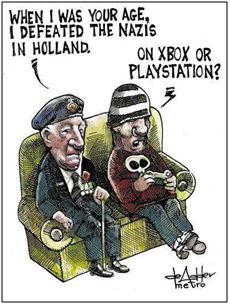


Newsletter/Nuusbrief 138
March/Maart 2016 The Members’ slot was filled by Pat Irwin who gave a brief presentation on the Heldenorgel in the town of Kufstein in western Austria. This open air organ, the largest in the world, is a living memorial to the Austrian fallen of the First and Second World Wars. Located in the 13th century Festung, the organ is played each day at noon and can be heard throughout the town and surrounding hills.
The curtain raiser, the South African Women’s Auxiliary Service (SAWAS) was presented by Letitia Jacobs.
The South African Women’s Auxiliary Services (SAWAS) was given its official status after the outbreak of the Second World War at a Conference in Pretoria in November 1939 and became affiliated to the Union of South Africa’s Department of Defence. It had its origins in the voluntary organisation, the Women’s National Service Legion, formed at the end of 1938. It was decided that an organisation be formed under the leadership of Mrs J.J. Pienaar, wife of the Administrator of the Transvaal, based along similar lines and incorporating the existing women’s organisations. SAWAS consisted of 408 branches with almost 65 000 members, each under the command of a Provincial Commandant.NancyAnderson was the Provincial Commandant of Command 2, Eastern Province.
By December 1943 volunteers at SAWAS ran 213 institutions that included soldiers' clubs, canteens, dining rooms, reading and recreation rooms, mobile refreshment units, after-care homes, crèches and hostels. One of its most widespread schemes was the hospitality scheme, under which members arranged private hospitality for servicemen on leave, including thousands of men from overseas who spent time ashore as convoys passed the Cape. By 1943, 25 000 officers and men had stayed in private homes around Cape Town. SAWAS thus became synonymous with service to men in the Forces and their dependants. In the countryside, SAWAS drivers used their own cars to save servicemen train travelling time. The organization was largely responsible for the warm welcome that the ships carrying Allied troops – mostly Australians and New Zealanders who were travelling through the Suez Canal to and from the battle fronts – received in Durban and Cape Town. These women, who became known as the "Universal Aunts of South Africa", took the lead in this welcoming which included organising dances, beach- and tea parties, excursions, shows and dinners, clubs and cafeterias where the troops could feel at home.
South African women have a long history of service in the military. They served in auxiliary roles in the SADF during the First and Second World Wars, and were assigned to active, non-combat duties after 1970. The army established a volunteer nursing service in 1914 and sent 328 nurses to serve with South African troops in Europe and East Africa in the First World War. The Women's Auxiliary Army Service began accepting women recruits in 1916. Officials estimated that women volunteers relieved 12 000 men for combat during the First World War by assuming clerical and other duties. During the Second World War, South Africa had five service organizations for women consisting of the South African Military Nursing Service, and women's auxiliaries attached to the army, the navy, the air force, and the military police. Many women were also trained for coastal defence units, to handle sophisticated radar equipment and odometers, to serve in ammunition factories, and in clerical and administrative positions in one or other of these military branches.
Three of the many outstanding women who served SAWAS are:
* Phyllis Doreen Dunning (nee Hooper) was the first South African woman to volunteer for full-time war service on 1st June 1940. She was only 22 years old when she became the Officer Commander of the South African Women's Auxiliary Air Force (SAWAAF), with the rank of Major. She was the youngest officer in the British Commonwealth to attain this rank. Prime Minister Jan Smuts had asked her to join up. On 28th June 1940, the first group of 120 women were taken into full-time service. Five months later there were 800 SAWAAFs proudly wearing the orange flash, signifying they had volunteered for overseas service. Doreen died in Howick, South Africa, on 26th August 2008 at age 91.
* The grandmother of Tiaan Jacobs, Cornelia Alletha De Wet, was involved with the SA Military Nursing Service in Sterkstroom for the full duration of the war and was also involved with the mobile refreshment trucks that provided essential survival packs for military personnel and civilians in need. For her selfless assistance and voluntary service to the Union of South Africa, she was honoured with the South African Medal for War Services 1939-1945.
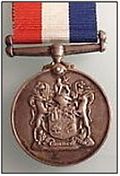
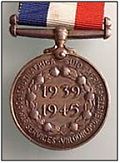 South African Medal for War Services 1939-1945
South African Medal for War Services 1939-1945
The main lecture presented by Tiaan Jacobs was entitled Rorke’s Drift 1879 – against all odds. Tiaan’s interest in Rorke’s Drift was aroused after he was awarded the John Chard Medal in 1984. As a result of his research he discovered that it had been established in honour of Lieutenant John Rouse Marriot Chard VC, Royal Engineers, who in 1879 commanded the defence of Rorke’s Drift, repelling attacks by Cetshwayo’s army. Lt. Chard set an outstanding example of the value of preparedness and of the qualities of leadership and perseverance in the face of overwhelming odds.
Rorke's Drift was a mission station and the former trading post of James Rorke, an Irish merchant. The mission belonged to the Reverend Otto Witt, a Swede. Witt’s church had been turned into a store by the British Army and his house into a military hospital under Surgeon James Reynolds. It was located near a drift on the Buffalo (Mzinyathi) River, which at the time formed the border between the British colony of Natal and the Zulu Kingdom. The Central Column of Lord Chelmsford’s invading army crossed the Buffalo River into Zululand at Rorke’s Drift on 11th January 1879.
On 22nd January 1879 over 1000 British troops, principally the 1st Battalion 24th Foot, were virtually annihilated in a bloody confrontation at the Battle of Isandlwana. On the same day a part of the Zulu army proceeded to Rorke’s Drift where, in the evening and into the night, they attacked the soldiers of B Company 2/24th Regiment and others who had been ordered to remain at the supply depot there. One hundred and thirty-nine British soldiers successfully defended their garrison against an intense onslaught by four to five thousand Zulu warriors. The overwhelming Zulu attack came very close to defeating the small British garrison. Its repulse and withdrawal helped to restore the prestige of British arms by their successful defence of the mission station.
Brevet Major, Henry Spalding (104th Regiment) had been in overall command of the post. His responsibilities included keeping open lines of communication and making sure that supplies were moved forward to the main force in enemy territory. Anxious that two extra companies of the 24th Regiment had not arrived from the fort at Helpmekaar, Spalding decided to go and see if anything was amiss. Lt. Chard was the next most senior officer. Spalding left camp with the immortal words: “You will be in charge, although, of course nothing will happen, and I shall be back again early this evening.”
Chard, who was primarily responsible for maintaining the pontoons positioned on the Buffalo River, and a hand-full of men from 5th Company had arrived in Durban on the 5th January and were at Rorke’s Drift by the 19th. Three days later he was in command of the garrison although he had never seen any action. The role of second-in-command devolved upon Lt. Gonville Bromhead of B Company 2/24th. Acting upon a warning that the Zulu army was advancing on them, the British garrison set to fortifying the mission station. Tents were struck and stored and the buildings loop-holed for defence. The complex was reinforced by building walls of mealie bags and biscuit tins.
When the Zulu army advanced on the mission station in the late afternoon they were met by heavy fire from the garrison and so, at some 50 yards from the wall, veered around the hospital to attack from the North West. They were driven back by the fire from the garrison and went to ground in the undergrowth, uncleared due to the shortage of time. The main body of Zulus opened fire on the British from cover around the mission station. The hospital at the western end of the fortifications became the focus for the fighting. When it was set on fire and stormed by the Zulus, the situation became untenable. As many men were extracted as possible, the remaining patients perishing in the flames.
Privates John Williams, Henry Hook, William Jones, Frederick Hitch and Corporal William Allen received the Victoria Cross for their defence of the hospital building. Fighting with bayonets after their ammunition was expended, they contested every room with the attacking warriors. The fighting then concentrated on the wall of biscuit tins linking the mission house with the mealie bag wall. As night fell the British withdrew to the centre of the station where a final bastion had been hastily assembled. The light from the burning hospital assisted the British in their firing. The Zulu attacks were resisted until around midnight when, unexpectedly, the ferocity of the assault fell away. Firing continued until around 4am when the Zulus withdrew. By then the British held only the area around the storehouse. At 7am a body of Zulus appeared on the hill, but no attack followed.
This success is held as one of history's finest defences. Eleven Victoria Crosses were awarded to the defenders of the Rorke’s Drift mission station, along with a number of other decorations and honours. Lieutenants Chard and Bromhead were each awarded the Victoria Cross and promoted to the rank of major. In addition to the soldiers of the 24th who distinguished themselves in the defence of the hospital, Victoria Crosses were awarded to Surgeon Reynolds, Commissary Dalton and Corporal Schiess of the Natal Native Contingent. Five others were awarded the Distinguished Conduct Medal. The 1879 Zulu War medal was subsequently established to honour all those British soldiers who participated in the Anglo-Zulu War.
Just as it was incomprehensible to the public in Britain that 1 000 British infantry armed with modern breech loading rifles could be overwhelmed by soldiers armed principally with stabbing spears, it was astounding that a handful of the same troops could withstand the overwhelming attack delivered against their comrades later the same day. In addition to their traditional weapons, the Zulus had captured some 1 000 Martini Henry breech loading rifles and a large amount of ammunition. Some of these rifles were used at Rorke’s Drift. All the British casualties, few though they were, were shot rather than stabbed.
It is estimated that between 20 000 and 25 000 rounds were fired during the defence of Rorke's Drift, the vast majority of the shots having missed their targets altogether. According to Lt. Chard's report, the number of Zulu dead buried by the British was 351. It is estimated that another 300 Zulus died later as a result of wounds sustained during the battle. So, conservatively speaking, every 25th shot fired by the defenders of Rorke's Drift resulted in an eventual Zulu death, and every 50th shot was an outright kill.
It seems that a number of the defenders of Rorke’s Drift may subsequently have suffered from what is now known as Post Traumatic Stress Disorder: Corporal Schiess fell ‘on hard times’ and died in 1884 aged 28 years; Pte John Fielding’s hair is said to have turned white shortly after the battle; William Jones in old age suffered from nightmares that the Zulus were about to attack; and Robert Jones shot himself in 1896.
A rare and interesting medalet is believed to date from the time of Cetshwayo’s imprisonment. Local tradition in Cape Town has it that Cetshwayo was in the habit of presenting his medal to the more important of his many visitors. This little oval medalet in cheap metal is 16 mm by 13 mm and has a perforated 'ear' at the top through which is tied a little bow in white string. On the obverse is portrayed a fine Zulu head with decorative headdress, facing left. Above, in tiny letters, is the name 'CETSHWAYO'. On the plain reverse, in capital letters, in four lines is the inscription: 'THE ZULU WAR MEDAL'.
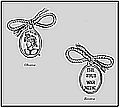
Medalet
Although Cetshwayo had no bronze crosses or silver medals with which to decorate his heroes, he had a means of showing his special approbation. The wood of the Umzimbete or uMyezane tree was especially reserved, on pain of death, for the Zulu king. From it, little dumbbell-shaped beads were cut which, if strung together, formed an interlocking necklace. These beads were given to Zulu warriors who specially distinguished themselves in battle. A warrior wearing a necklace of these beads was regarded with no less respect than a British holder of the Victoria Cross. The John Chard Medal and Decoration was instituted from 6th April 1952 and was awarded for long and efficient service in the conventional SADF Citizen Force. After 20 years’ service a recipient could qualify for the John Chard Decoration, and from 1986 no longer had to stop wearing theMedal once he/she had received the Decoration.
The oval medal is of bronze and the designation and significance is the same as that of the John Chard Decoration. Distinguishing insignia in silver are worn on the ribbon to indicate the arm of the SADF in which the qualifying service was carried out: Army – miniature crossed swords; Air Force – miniature eagle; and Navy – miniature anchor.
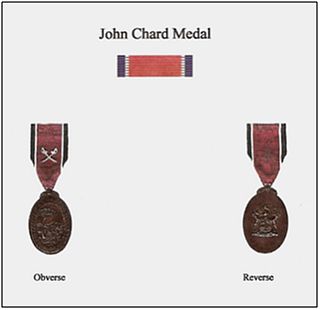
John Chard Decoration
Obverse: Depicts in relief the commissariat store and hospital which formed part of the defence of Rorke’s Drift in 1879.
Reverse: Depicts the SA coat of arms.
Ribbon: 32 mm in width, central broad 22mm red stripe, with 3mm navy blue (outer) and 1.5mm white (inner) stripes on either side, representing the colours of the British flag.
For a full transcript of this talk please contact Tiaan at tiaan.j@vodamail.co.za
Future meetings and field trips/ Toekomstige byeenkoms en uitstappe
The next SAMHSEC meeting will be on Monday 14th March 2016 at 19h30 at the Eastern Cape Veteran Car Club in Conyngham Road, Port Elizabeth. The AGM will be held in lieu of the curtain raiser. The Chairman's and Treasurer's Reports for 2015/16 are attached.
The main lecture was intended to be by Wayne Westoby on his Experiences flying Mirage Jets for the SAAF during the Border War. Due to his flying schedule he is, however, unable to give it as planned. John Stevens has kindly agreed to bring forward the second part of his lecture titled Under wraps: the story of a top secret British military undertaking in 1915. (Part 2). Wayne will hopefully be able to address us at a later date.
Matters of general interest / Sake van algemene belang
New member /Nuwe lid
We welcome Derek Frielinghaus of Knysnaas a member of the South African Military History Society and SAMHSEC. We hope you will enjoy a happy association with the East Cape Branch and look forward to having you join us at meetings and field trips when you have the opportunity to do so.
Members’ forum/Lede se forum
In March 2012 (see SAMHSEC Newsletter 91) Donna Cilliers, in her lecture on Wartime Animals drew our attention to Wojtek, the Syrian Brown Bear who served in an Artillery Supply Company of the Polish II Corps. Among his battle honours was the carrying and loading of ammunition at the Battle of Monte Cassino. Richard Tomlinson has suggested that we feature him again. 16 photographs and a brief description of his exploits can be found at Following on Ian Copley’s talk last month, Richard Tomlinson has drawn our attention to an article on the Samora Machel air crash monument. It can be viewed at http://www.theheritageportal.co.za/article/air-crash-monument-must
Lecture: Empire, War and Cricket in South Africa There will be a talk by Dr Dean Allen on his book, Empire, War and Cricket in South Africa: Logan of Matjiesfontein on Tuesday 29th March 2016 at 10h00 in the Auditorium of the Newton Park Library, corner of 4th Avenue and Hurd Street, Newton Park. This is under the auspices of the U3A (University of the Third Age) and non-members of U3A would be welcome on paying the princely admission fee of R10.00. The same lecture will be presented in Grahamstown on Friday 11th March at 17h30 for 18h00 in the Albany Club in High Street. This is under the auspices of the Grahamstown Historical Society.
SAMHS/ SAMHSEC Subscriptions
Members are reminded that annual subscriptions are due no later than the end of March to avoid being deleted from the mailing list.
World War I Centenary Years / Eerste Wêreldoorlog Eeufeesjare
Part 2 of 5 of John Steven’s ‘Road to the Somme’
Haldane’s (then Secretary for War) post-Boer War Reforms (1906-1912) resulted in the British Army becoming two primary formations: The British Expeditionary Force (BEF) for foreign operations and the Territorial Army (TA), an area protection force intended for service in the British Isles only. It essentially abolished the existing Volunteers and Yeomanry and used them to create a new territorial force of fourteen infantry divisions, fourteen cavalry brigades, and a large number of support units.
The total strength of the regular army in July 1914 was 233 000: 125 000 men in the British Isles, 75 000 in India and Burma and a further 33 000 in other overseas postings. In addition there were 145 000 men in the Army Reserve and 64 000 in the Militia (or Special Reserve). The territorial force was composed of 272 000 men. Interestingly, while a BEF Cavalry Division had been provided for by the reforms, it had not been constituted by the outbreak of war in 1914. Five independent Cavalry Brigades were then combined into a Cavalry Division of four Brigades leaving one remaining independent Brigade just after mobilization.
When Lord Kitchener became Secretary of State for War just after war was declared, he was one of the few to foresee a long war, lasting for at least three years. Having the authority to act effectively on that perception, he organized the largest volunteer army that both Britain and the world had seen through a massive recruiting campaign. This would raise Kitchener’s so called ‘New’ Armies.
Battle of Salaita Hill
The 100th anniversary of the Battle of Salaita Hill,in which there was a substantial involvement of South African troops, took place on 12th February. It was the first large-scale engagement of the East African Campaign. For a detailed account of the battle see the [South African] Military History Journal 16 (6) 202-210 December 2015
Major engagements in March 1916
During March the Germans continued their offensive at Verdun, the second major waves of attacks starting on 6th March. Under increasing pressure at Verdun, the French pressed their allies to launch offensives of their own to draw German forces away from the city. Britain responded with the Battle of the Somme in July, the Italians with the 5th Battle of the Isonzo commencing on 9th March, while the Russians launched an offensive in the Vilna-Naroch area (today’s Lithuania) on 18th March.
The Italian army was at this stage, however, ill-prepared for a further Isonzo offensive and in no condition to renew hostilities. As with the previous four battles of Isonzo, this one failed to achieve its objectives and the attack was abandoned on 17th March. Subsequently the Austro-Hungarians were able to launch their own counter-offensive in the Trentino area on 15th May. (This is to be covered in Newsletter 140).
Preceded by a wildly inaccurate two-day artillery bombardment – the heaviest to date on the Eastern Front – the Battle of Lake Naroch was launched on 18th March 1916. Russia’s Second Army consisting of 350 000 men and 1 000 guns was ranged against just 75 000 men and 400 guns of the German Tenth Army. The Russian infantry assault following the artillery bombardment rapidly became bogged down in the mud of the spring thaw, bunched up during the attack and consequently made easy targets for artillery and machine gun fire. The situation was compounded by the characteristically ill-prepared and ineffective Russian commissariat and its inability to supply the troops with victuals and ammunition. The attack was a notable failure.
Artillery attacks continued into April, but German counter-attacks succeeded in recovering what little ground the Russians had succeeded in capturing. The Germans suffered 20 000 casualties at Lake Naroch and the Russians 70 000.
These three attacks had not caused the Germans to divert resources from Verdun and in this respect alone they were notable failures. Shortly after the Lake Naroch debacle the Russians heeded another call for help, this time from the Italians. The Russian response on this occasion, known as the Brusilov Offensive, was markedly more effective. (This is to be covered in Newsletter 141).
On the middle eastern front, in a further attempt to relieve the besieged British force at Kut-al-Amara (see Newsletters 135 and 136), an attack was made on the Turkish-held redoubt at Dujaila on 8th March. This strong point was held by 25 000 experienced troops, many of whom had fought at Gallipoli. Stopped 700 metres short of the redoubt, the British attack faltered and was subsequently called off with the loss of 3 500 casualties. Turkish losses were 1 200.
Naval developments
Due to the continuing British naval blockade and attempted starvation of Germany, the first calls for a resumption of unrestricted submarine warfare were made in March 1916. It was ultimately resumed only in February 1917 and proved highly successful in terms of tonnage sunk. To combat this, the British began full-scale convoying in September 1917. The first effective depth charge, the ‘Type D’, developed in Britain became available in January 1916. Initially they were not very effective – only nine U-boats being sunk up to the end of 1917. The first U-boat to be sunk by a depth charge was the U-68 off Kerry, Ireland, on 22nd March 1916. Only six days into her first war patrol, she was sunk with all hands by the Q-ship Farnborough. U-68 sank no ships in her brief career. A post-war German study found fault with U-68's captain for not following established procedures for avoiding decoy ships.
Websites of interest/Webwerwe van belang
World War I
10,000 soldiers die in Tyrol from avalanches during World War I
Jennifer Rosenberg About.com 7th January
2016
World War II
Island in the Pacific is home to countless WWII relics
Charlene Sakoda Yahoo News 20th March 2014
Soviet image manipulation for propaganda purposes during WW II
War History Online 2/4/2015
Historic aircraft
The last flight of the Royal Navy Sea Kings
Alex Matthews Mail Online 14th January 2016
The Scotsman 14th January 2016
One of the best aircraft designs of the 20th century? Junkers Ju 52 – The flying tool shed
War History Online 18th October 2015
Separating fiction and fact: The B-17 All American story
WarBirds News 27th June 2013
To snatch an F-86 Sabre in North Korea
Ralph Wetterhahn Air & Space Magazine July 2003
The F-4 Phantom – good pictures
War History Online 11th February 2016
Once-feared 'Zero' fighter flies again over Japan
Thom Patterson CNN 29th January 2016
Historic ships
The last of the Monitor warships [An interesting 9 minute video]
https://www.youtube.com/watch?v=gN5bttadERs
Fortifications
World War Two sea forts to be developed into a luxury hotel
War History Online 16th January 2016
Images of the massive German flak towers, which could also shelter thousands
War History Online 24th January 2016
Spooks and spying
Lebanon returns Israeli vulture cleared of spying
Anon BBC News 30th January 2016
http://www.bbc.com/news/world-middle-east-35446528
Resource materials of military historical interest/
Bronmaterieel van krygsgeskiedkundige belang
BOOK REVIEW
Steyn Willie 2015 The Great Boer Escape Cape Town Cederberg Publishers
This is the story of five ordinary commando members’ escape from the certainty of British imprisonment in Ceylonand, for some of them, their remarkable return, via Russia and Europe, to South Africa to re-join the fight against the British. It is told with a combination of humour and sadness, but always with iron determination as to the ultimate goal. Helga Steyn has translated her grandfather’s story into eloquent English which constitutes the first half of the book. The original Dutch manuscript upon which the book is based, constitutes the second half and is also easy enough to read for anyone with a reasonable working knowledge of Afrikaans. In sum, this is a fascinating and very modest account and is truly a ‘must read’ for all Anglo-Boer War enthusiasts for it covers an aspect of the conflict we very seldom hear about. The book is unfortunately overpriced in relation to its length.
73pp with 8 pp of b&w photographs p/b R250.00 Also Available on Kindle.
EXCELLENT ONLINE RESOURCE
1914-1918-online. International Encyclopaedia of the First World War
1914-1918-online – International Encyclopaedia of the First World War is an English-language online reference work on the First World War. Launched in October 2014, the multi-perspective, public-access encyclopaedia is a collaborative project by the largest network of First World War researchers worldwide, spanning more than 50 countries. 1914-1918-online features innovative navigation and search functions based on semantic wiki technology. There are currently 813 articles on a very wide range of topics and issues,and the final product is projected to eventually contain more than 1000 articles. For further information and insights see:
http://www.1914-1918-online.net/ and
http://encyclopedia.1914-1918-online.net/articles/ for a full list of items published thus far.
Two recent additions to this work are:
* The phantom airship panic of 1913: imagining aerial warfare in Britain before the Great WarbyBrett Holman.
The full article is accessible at:
Members are invited to send in to the scribes, short reviews of, or comments on, books, DVDs or any other interesting resources they have come across, as well as news on individual member’s activities. In this Newsletter, there have been contributions by Richard Tomlinson, Andre Crozier, Malcolm Kinghorn, Barry Irwin, Michael Irwin and Peter Duffel-Canham.
Chairman: Malcolm Kinghorn: culturev@lantic.net
Secretary: Franco Cilliers: Cilliers.franco@gmail.com
Scribes (Newsletter): Anne and Pat Irwin: p.irwin@ru.ac.za
TAILPIECE:
